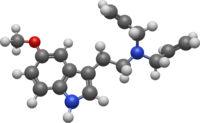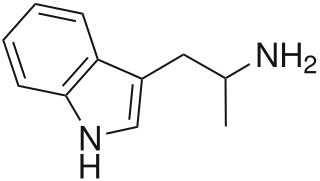
α-Methyltryptamine is a psychedelic, stimulant, and entactogen drug of the tryptamine class. It was originally developed as an antidepressant by chemists at Upjohn in the 1960s, and was used briefly as an antidepressant in Russia under the trade name Indopan before being discontinued.

2C-T-2 is a psychedelic and entactogenic phenethylamine of the 2C family. It was first synthesized in 1981 by Alexander Shulgin, and rated by him as one of the "magical half-dozen" most important psychedelic phenethylamine compounds. The drug has structural and pharmacodynamic properties similar to those of 2C-T-7.

5-MeO-DMT (5-methoxy-N,N-dimethyltryptamine) or O-methyl-bufotenin is a psychedelic of the tryptamine class. It is found in a wide variety of plant species, and also is secreted by the glands of at least one toad species, the Colorado River toad. Like its close relatives DMT and bufotenin (5-HO-DMT), it has been used as an entheogen in South America. Slang terms include Five-methoxy, the power, bufo, and toad venom.
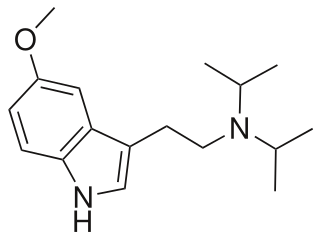
5-Methoxy-N,N-diisopropyltryptamine is a psychedelic tryptamine and the methoxy derivative of diisopropyltryptamine (DiPT).

5-MeO-aMT or 5-methoxy-α-methyltryptamine, α,O-Dimethylserotonin (Alpha-O) is a potent psychedelic tryptamine. It is soluble in ethanol.

4-Hydroxy-N,N-diisopropyltryptamine is a synthetic psychedelic drug. It is a higher homologue of psilocin, 4-HO-DET, and is a positional isomer of 4-HO-DPT and has a tryptamine molecular sub-structure.

Diisopropyltryptamine is a psychedelic hallucinogenic drug of the tryptamine family that has a unique effect. While the majority of hallucinogens affect the visual sense, DiPT is primarily aural.

5-MeO-MiPT is a psychedelic and hallucinogenic drug, used by some as an entheogen. It has structural and pharmacodynamic properties similar to the drugs 5-MeO-DiPT, DiPT, and MiPT. It is commonly used as a "substitute" for 5-MeO-DiPT because of the very similar structure and effects.

5-MeO-DET or 5-methoxy-N,N-diethyltryptamine is a hallucinogenic tryptamine.
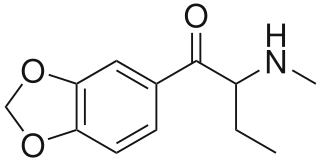
Butylone, also known as β-keto-N-methylbenzodioxolylbutanamine (βk-MBDB), is an entactogen, psychedelic, and stimulant psychoactive drug of the phenethylamine chemical class. It is the β-keto analogue of MBDB and the substituted methylenedioxyphenethylamine analogue of buphedrone.

4-HO-MiPT is a synthetic substituted aromatic compound and a lesser-known psychedelic tryptamine. It is thought to be a serotonergic psychedelic, similar to magic mushrooms, LSD and mescaline. Its molecular structure and pharmacological effects somewhat resemble those of the tryptamine psilocin, which is the primary psychoactive chemical in magic mushrooms.

N-methyl-N-isopropyltryptamine (MiPT) is a psychedelic tryptamine, closely related to DMT, DiPT and miprocin. It was first synthesized by David Repke in 1984 and was subsequently evaluated and described in Alexander Shulgin's 1997 book TiHKAL.

5-MeO-DPT, is a psychedelic and entheogenic designer drug.

N-Methyltryptamine (NMT) is a member of the substituted tryptamine chemical class and a natural product which is biosynthesized in the human body from tryptamine by certain N-methyltransferase enzymes, such as indolethylamine N-methyltransferase. It is a common component in human urine. NMT is an alkaloid derived from L-tryptophan that has been found in the bark, shoots and leaves of several plant genera, including Virola, Acacia, Mimosa, and Desmanthus—often together with the related compounds N,N-dimethyltryptamine (DMT) and 5-methoxy-N,N-dimethyltryptamine (5-MeO-DMT).

O-Acetylpsilocin is a semi-synthetic psychoactive drug that has been suggested by David Nichols to be a potentially useful alternative to psilocybin for pharmacological studies, as they are both believed to be prodrugs of psilocin. However, some users report that O-acetylpsilocin's subjective effects differ from those of psilocybin and psilocin. Additionally, some users prefer 4-AcO-DMT to natural psilocybin mushrooms due to feeling fewer adverse side effects such as nausea and heavy body load, which are more frequently reported in experiences involving natural mushrooms. It is the acetylated form of the psilocybin mushroom alkaloid psilocin and is a lower homolog of 4-AcO-MET, 4-AcO-DET, 4-AcO-MiPT and 4-AcO-DiPT.

4-HO-MET is a lesser-known psychedelic drug. It is a structural and functional analog of psilocin as well as the 4-hydroxyl analog of methylethyltryptamine (MET). 4-HO-MET was first synthesized by Alexander Shulgin. In his book TiHKAL, the dosage is listed as 10-20 mg. 4-HO-MET produces psilocin-like distortion of color, sound, and form. Very little data exists about the pharmacological properties, metabolism, and toxicity of 4-HO-MET. There have been no reports of deaths from 4-HO-MET, even though there exist anecdotal reports of the ingestion of up to 150 mg, more than an order of magnitude above the effective dose.
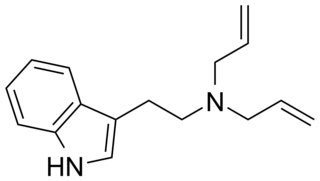
N,N-Diallyltryptamine (DALT) is a tryptamine derivative which has been identified as a new psychoactive substance. It has been used as an intermediate in the preparation of radiolabeled diethyltryptamine.

Substituted tryptamines, or serotonin analogues, are organic compounds which may be thought of as being derived from tryptamine itself. The molecular structures of all tryptamines contain an indole ring, joined to an amino (NH2) group via an ethyl (−CH2–CH2−) sidechain. In substituted tryptamines, the indole ring, sidechain, and/or amino group are modified by substituting another group for one of the hydrogen (H) atoms.

4-acetoxy-MET (4-acetoxy-N-methyl-N-ethyltryptamine), also known as 4-AcO-MET or metacetin, is a hallucinogenic tryptamine. It is the acetate ester of 4-HO-MET, and a homologue of 4-AcO-DMT. It is a novel compound with very little history of human use. It is sometimes sold as a research chemical by online retailers.

MALT is a lesser-known drug from the tryptamine family. It is a novel compound with very little history of human use. It is closely related to methylpropyltryptamine (MPT), as well as N-methyltryptamine. It has been sold online as a designer drug. Very little information on the pharmacology or toxicity of MALT is available.

